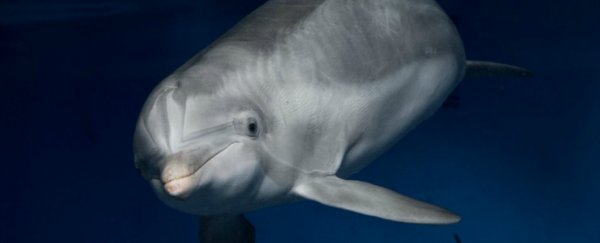Hey, kids: Science can be sexy - super sexy. Just ask Dara Orbach, who has spent seven years studying dolphin vaginas, and her colleagues Patricia Brennan and Diane Kelly, who are some of the foremost experts on animal penises.
They recently combined forces to solve the mystery of just how dolphins and other cetaceans do the deed, a task that involved inflating penises, fitting them into vaginal tracts and taking pictures of it all.
This is groundbreaking stuff, because most studies of animal genitalia have focused on males' more accessible body parts.
And most research into how penises and vaginas mesh during copulation has looked at small arthropods such as fruit flies, which scientists have dunked into liquid nitrogen during the heat of the moment, freezing the insects' embrace for all time.
That technique is, obviously, infeasible with the large marine mammals studied by Orbach, a postdoctoral fellow at Dalhousie University in Nova Scotia and research associate at Mount Holyoke College in Massachusetts.
But how dolphins copulate is a mystery just begging to be investigated, she said.
For starters, dolphin sex takes place under trying circumstances. The animals must properly connect despite ocean currents, and salty seawater, which is lethal to cetacean sperm, must be kept out of the uterus.
What's more, dolphins, porpoises and whales have vaginas with extremely unusual twists, folds and recesses - you might say they are kinky - that sperm must traverse to make a baby.
 Image reconstructed from CT scans shows how the penis of the common bottlenose dolphin (red) fits within the intricate folds and turns of a bottlenose dolphin vagina. Credit: Dara Orbach/Dalhousie University
Image reconstructed from CT scans shows how the penis of the common bottlenose dolphin (red) fits within the intricate folds and turns of a bottlenose dolphin vagina. Credit: Dara Orbach/Dalhousie UniversityTo investigate all this, Orbach collected dozens of reproductive tracts of dolphins, porpoises and seals that had died of natural causes and been scooped up from shorelines by government agencies such as the National Oceanic and Atmospheric Administration's National Marine Mammal Stranding Network.
After performing necropsies, those agencies very cooperatively sent the specimens to her.
"Surprisingly, it's not a very popular field to look at dolphin genitalia," Orbach said.
Kelly, who has also studied alligator and armadillo penises, came up with the idea of inflating the male organs, which are also twisty.
The team did so with a pressurised pump - one more like a beer keg than the kind used to inflate bike tires - and then fit those into the matching vaginas. To find out what it all looked like inside, they used a computed tomography (CT) scanner.
"We were really baffled at just how close a correspondence there was," Orbach said.
The scans, some of which Orbach presented last month at the American Association of Anatomists annual meeting in Chicago, amount to the first look at the internal mechanics of marine mammal sex.
Orbach said they add evidence to the idea that the convoluted geography of cetacean vaginas evolved to make it challenging for sperm to fertilize eggs, ensuring that the fittest male wins.
"This could be a way to induce the best possible sperm, or the most competitive male, to achieve paternity," Orbach said, adding that a female can slightly twist her body during the deed to make it even harder for the sperm to complete the journey.
Why would female dolphins want to make conception difficult? Because they have lot of suitors, and reproduction is time-consuming.
At the height of their fertility, female cetaceans mate as many as 15 times in 15 minutes with two or three males, Orbach said. Pregnancy lasts 11 months, and calves are nursed for two years.
"It's a very substantial investment of a female's life in her developing fetus and calf as well," she said.
"So from a female's perspective, she wants some way to control who's going to be the father."
Orbach said the penis-inflation technique - and more broadly, a greater understanding of how reproductive anatomy works on the inside - could eventually help conservation biologists who study the captive breeding of endangered species.
Though the research made a big splash in the news media, Orbach said her talk at the Chicago conference was not very well-attended - which was, ahem, "anti-climactic" after all the requests for interviews, she said.
But the presentation has resulted in several new offers of specimens from agencies that collect marine mammal carcasses.
"It's all pretty - and it's weird to use this word - exciting," Orbach said.
2017 © Washington Post
This article was originally published by The Washington Post.
